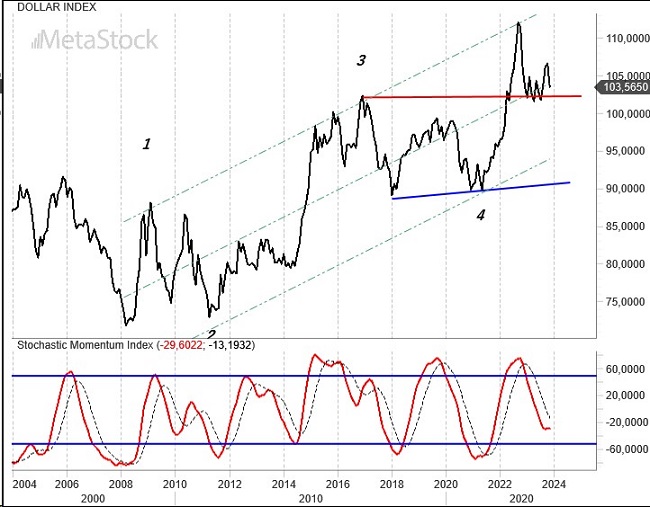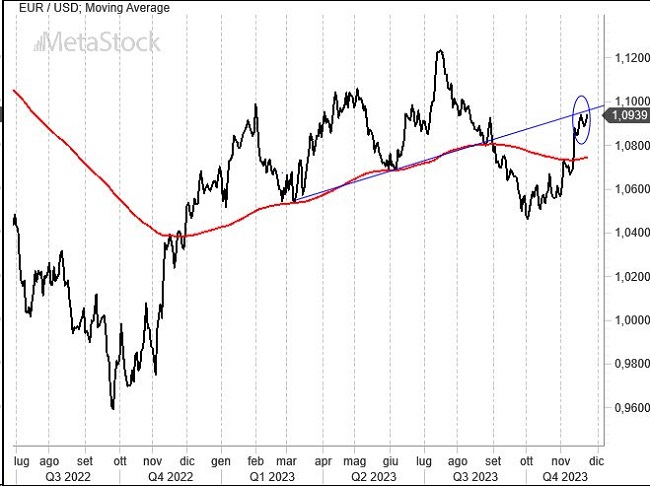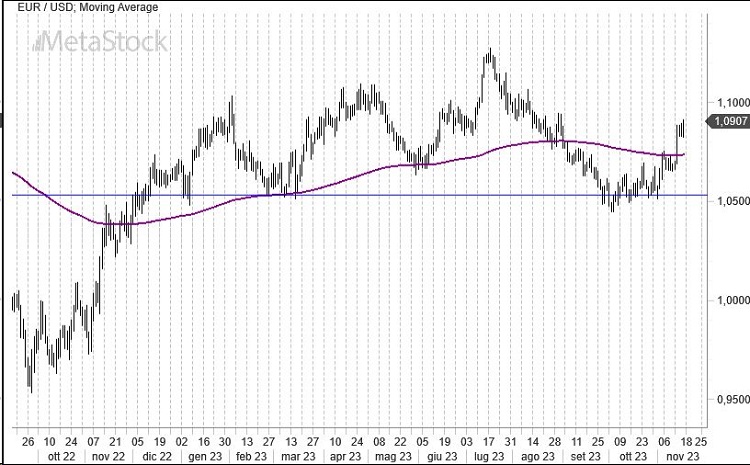- Powell’s strategy appears increasingly successful with an economic soft landing that has averted a recession, favoring a steady retreat of inflation from the record levels of 2022.
- Europe has been more focused on election outcomes in the Netherlands than on limited macroeconomic data. There is an apparent rightward shift in Europe, and next year’s European Parliament elections will be a significant test.
- EurUsd remains near important resistance levels, moving away from the 200-day moving average, which will now act as support. The 1.10 area is the next significant hurdle.
Europe Shifts Rightward
The market is keenly awaiting the pivotal December meetings of the world’s two most significant central banks, the FED and the ECB. Long-term bond yields have dipped to around 4.5% for ten-year bonds, with the stock market holding steady at monthly highs. There’s a growing belief in a more dovish FED, buoyed by the Atlanta FED’s forecast of over 2% GDP growth for the fourth quarter. This is seen as a masterstroke by the much-criticized Powell, effectively managing what is essentially a well-engineered soft landing.
From Euroland, there are no significant new developments. The ECB’s representatives alternate between hawkish and dovish tones, leading to no expectations of interest rate hikes or cuts until March. Bets are beginning to be placed on potential rate reductions from May onwards. Meanwhile, Europe is rocked by the far-right party’s win in the Dutch elections, coupled with the right-wing party’s success in Italy in 2022, confirming a gradual political shift in some key Eurozone countries. This shift could be crucial in the run-up to the 2024 European elections, potentially altering the EU’s economic policy.
EurUsd Technical Analysis – Navigating Key Resistances
Seasonality suggested some weakness in the dollar, and as the year ends, this is contributing to a strengthening of the euro, which could soon challenge resistance levels between 1.12 and 1.13. The Dollar Index continues its corrective phase after completing a five-wave rise. Typically, this is followed by a correction, which, if it takes the classic zigzag shape, could indicate at least a further 5% drop for the greenback, potentially testing the lower bound of its long-term bullish channel. The stochastic oscillator, effective in signaling the previous top, will help us better define the contours and timing of a bottom that is still not near. Hence, the dollar’s correction phase is not yet over.

Minutes from the FED’s November meeting revealed a central bank leaning towards maintaining high vigilance on rates, not ruling out new maneuvers if inflation improvement proves insufficient, but also proactive in responding to future macroeconomic data. While American economic growth remains strong, the market, continuing to sell dollars, deems it insufficient.
Technically, we are facing a significant resistance. After a clear bullish break of the moving average, EurUsd predictably targets the 1.10 area, where significant resistance is found. Connecting the recent increasing lows, the trend line passes right through here.
A pullback is possible (with the moving average again acting as support), but the sentiment does not seem encouraging enough to foster strong bullish expectations on the euro, nor on the dollar. The market will likely enter a range until the next ECB and FED meetings, and will reassess afterwards whether to challenge the 1.12/1.13 area or retreat to the 1.075 zone.



Leave a Reply
You must be logged in to post a comment.